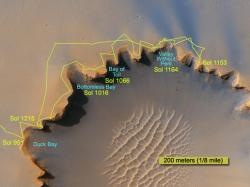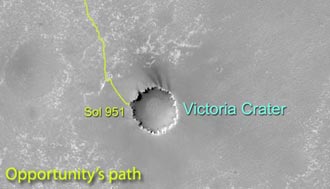NASA's robotic space vehicle - Opportunity, is preparing to descend into the Victoria crater to continue research on the planet Mars. This mission involves many risks that may cause damage to the spacecraft, but the team of researchers claims that this is a necessary risk for the continuation of scientific research on the Red Planet

In the photo: the marking of the route of the opportunistic space vehicle on the edge of the Victoria crater. Photo: NASA
NASA's robotic space vehicle - Opportunity, is preparing to descend into the Victoria crater to continue research on the planet Mars. This mission involves many risks that could cause damage to the spacecraft, but the team of researchers claims that this is a necessary risk for the continuation of scientific research on the Red Planet.
Opportunity has already explored the rocky layer on the edge of the cliff around Victoria Crater and is now preparing to descend into it. The research team has planned a return ascent route, but the spacecraft may remain inside the crater if any problem occurs. It should be remembered that the space vehicle operated 12 times more than the 90 days planned for it.
The scientific attraction for the upcoming journey is the chance to test and study the components of the materials exposed in the depth of the crater, in order to find clues about the existence of water liquids. As the spacecraft travels safely down the slopes of the crater, it will be able to examine more and more of the ancient rocks on its walls and provide information and data about the geological processes of the planet.
"While we take seriously the fact that the spacecraft will not be able to climb back up, the scientific potential inherent in the research convinced me to ask the research team to lower the vehicle to the base of the crater," says Dr. Alan Stern, mission manager at NASA Headquarters, Washington. "This is a calculated risk worth taking, especially because this mission has long since outlived its original purpose."
A meteor collision millions of years ago created the Victoria Crater, which is 6.5 km south of the landing site of the Opportunity space vehicle in January 2004. The size of the crater is 800 meters and 5 times wider than the Endurance Crater, where the vehicle operated space for six months in 2004.
The robotic geologist will enter the Victoria Crater through an alcove called "Duck Bay". In the crumbling crater there is a steep cliff with sloping niches. The spacecraft began its journey from Endurance Crater to Victoria Crater 30 months ago. He reached the edge of Duck Bay nine months ago.
Opportunity continued his ride on the edge of the cliff about a quarter of the way clockwise, while conducting tests and research on the rocky surface and watching from the cliff in search of a possible route to travel down from one of the alcoves. Now the spacecraft returns to the most promising point to begin its descent.
"Duck Bay seems like the best place to go into the crater," says John Callas, NASA's Space Vehicle Project Manager at the Jet Propulsion Laboratory in Pasadena, California. "There are slopes between 15 and 20 degrees and a well-known infrastructure that will allow safer travel."

If the six wheels work properly, the engineers expect a good opportunity to return the spacecraft to the rim of the crater. On the other hand, to remember, that the twin space vehicle - Spirit, lost the activity of one of the wheels, thus reducing its climbing capacity.
"The time of these space vehicles has passed and another wheel could lose its activity at any time", adds John Callas. "If the Opportunity spacecraft loses one of its wheels, it will be almost impossible to get it back up to the edge of the cliff."
"We don't want it to be a one-way trip," says Steve Squier, director of space vehicle development research at Cornell University, in Ithaca, New York. “We still have some excellent targets in the planning after the mission at Makhtesh and Victoria. But if Opportunity finds a trap inside the crater, it will still be worth the knowledge we will gain."
Translation: Yariv Zerbiv

5 תגובות
You really don't need to go down there
Nothing to look for there
It's just dangerous
It's a shame to destroy the robot
For 3, don't worry, it will be fine and you will fix the positive bug
Isn't the (almost certain) risk of losing the "opportunity" too great??? Shouldn't it be preferable to extend his life on Mars and at the same time explore more distant areas??
Maybe it is more exotic to descend into a crater, but the consideration should be more rational: maximum utilization of the resources!!! After all, it is clear that the bottom of the crater is covered with a very thick layer of sand and dust and therefore, the chances of significant substrates, at the bottom of the crater, are zero. In addition, it is expected that the sand at the bottom of the crater is soft and submerged and then the "Opportunity" may sink there without being able to get out and within a few years there will be no trace of it, after being covered with a layer of sand. Undoubtedly a timely and cruel death. It will be very difficult to position the "Opportunity" on the cliffs and there is a risk of overturning, despite its great stability.
In conclusion: think twice or thrice before you take a step from which there is no going back.
About 70 meters deep.
What is the depth of the crater?